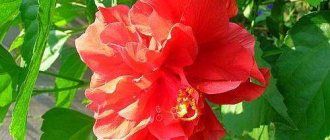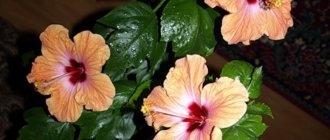The genus Hibiscus includes more than 220 species of deciduous or evergreen shrubs and herbaceous plants of the Malvaceae family. The vast majority of species are native to warm tropical regions and are therefore cultivated as houseplants in temperate climates.
Only two representatives of the genus are able to withstand frosty winters, and the most popular of them is the Syrian tree hibiscus - an ornamental shrub that does not require much time and effort to care for in the open ground.
The Syrian or garden hibiscus (Hibiscus syriacus) is native to the temperate subtropical regions of East Asia and is the official symbol of South Korea. In many countries it is often called the Rose of Sharon or the Syrian Rose.
Description
Garden tree hibiscus grows quite slowly; in its natural environment it can reach a height of more than 3 meters and a width of 2.5 meters. In garden culture it is a low bush or standard tree from 1.5 to 2 meters in height.
The shoots are rigid, straight, poorly branched, covered with dark green jagged leaves that appear on the shoots in late spring.
A distinctive characteristic of many varieties of Syrian rose is their late flowering period - from late July to October. This feature and the exotic appearance of the flowers made the tree hibiscus a real pearl of the outgoing summer.
Large flowers are formed on the shoots of the current year and, depending on the variety, can be simple, semi-double, double, with wavy petals along the edge, single-color or two-color, often with a contrasting eye in the center.
Types and varieties of spirea with photos
The color is presented in a wide range of colors - snow-white, lilac, purple and all shades of red. The most valuable forms are lavender-blue and blue-blue in color.
Varieties and varieties
Hibiscus is a plant that blooms with unusual and mesmerizing flowers with its graceful charm. It can grow not only on the windowsill in the apartment, but also in the garden. The specimen grown in the garden belongs to the Malvacea group. In nature, you can find approximately 250 varieties of this plant. All of them have a variety of shapes, sizes, colors and flower sizes.
Depending on the form, we can distinguish:
- Subshrub.
- Shrub species.
- Herbaceous varieties.
- Decorative trees.
Syrian hibiscus
It is also called Syrian (Chinese) rose, ketmia or garden hibiscus. This is the only type of plant that takes root well in the garden. The bushes have a rich green tint, as well as inflorescences of a wide variety of colors. After planting, this species will grow slowly, and will begin to bloom only 3-4 years after planting.
Tree garden hibiscus cultivation and care
It will delight gardeners with its flowers for six months, but the bloom of each flower lasts no more than one day. After some flowers have withered and fallen off, new ones bloom in their place . It begins to bloom in mid-summer and continues to produce new inflorescences until October.
Hibiscus tree
This specimen is a large bush (about 2 meters), completely covered with beautiful flowers. The inflorescences are somewhat reminiscent of mallow flowers, the diameter of which can vary from 10 to 25 cm. By the size of the flower you can determine whether the plant is a hybrid or not. The average size of a garden flower is considered to be approximately 10-15 cm in diameter.
In countries with a temperate climate it reaches up to 2.5 meters, while in natural living conditions the height of a tree-like specimen can reach up to 6 meters. And we get a hibiscus tree.
To achieve abundant flowering of the bush, it will need to be pruned once every 2 years. In order to protect the plant from aphid attacks, it is worth planting lavender next to it .
This variety is suitable for growing in pots , but there are some factors to consider. The place chosen for the plant should be ideal for it, since if you decide to rotate it or place it in another area of the garden, you can damage the fragile flower stalks. The chosen location should be well protected from drafts, as well as fairly warm and well lit by sunlight. In order to maintain the decorative shape of hibiscus grown in a pot, it must be trimmed occasionally.
The most common varieties of the species:
- Hibiscus Syrian Duc de Brabant
White hibiscus
It is a shrub or a small tree, not exceeding 2-3 meters in height, and the circumference of the entire plant is not more than 1.7 m. It has large double flowers of a violet-red hue with red-burgundy or dark red petals in the center. The inflorescences do not exceed 10-12 cm. Sunny areas are suitable for growing this species, but cultivation is also possible in slightly shaded areas.
- Hibiscus Lavender Chiffon
An English plant variety called Lavender Chiffon has recently been developed. It can be distinguished from other species by its semi-double or double inflorescences of a blue-pink hue with a bright red central part.
This is a small deciduous bush or tree of medium size, which does not exceed 3 meters. The circumference of the entire bush is about 1.7 m. It can grow in both sunny and slightly shaded areas.
- Diana
Pink hibiscus
A shrub plant whose height is about 2 m. It is characterized by 12 cm white flowers slightly wavy at the edges.
- Vayelit Ilar Double
A powerful plant with straight shoots, having double or semi-double violet-blue flowers with small red spots in the middle.
- Pink Giant
A bush with single pink flowers endowed with purple spots at the base of the petals.
- Corneus Plenus
Shrub with flexible trunks. It has double pale-pink flowers, the central part of which is endowed with a purple spot.
Trifoliate
The height of this species reaches almost 1 meter. It has lush petiolate leaves and medium-sized flowers of a light yellow hue. Flowering lasts quite a long time and lasts for 30 days. They bloom only for a few hours a day .
dissectedpetalous
This species begins to bloom its beautiful flowers at the end of spring and continues to delight the gardener until late autumn.
Its flowers are colored in rich red or orange shades. The size of the flowers is average, and the petals are slightly curled due to strong dissection. A very unusual and exotic type of blooming hibiscus that attracts everyone's attention.
The most famous variety is the Drummond hibiscus. It is characterized by a straight, highly branched stem, endowed with leaves with a dissected edge, reaching 5 cm. The flowers have 5 pink petals with a black central part.
Herbaceous hibiscus planting and care
It has many straight trunks, the number of which increases every year. The foliage of this species resembles sunflower leaves. As a rule, the inflorescences are white, raspberry or pink. Does not like shadows, preferring well-lit areas.
Red hibiscus
This species differs from the others in that it blooms for quite a long time, from early August to September. They have inflorescences that are several times larger than those of the tree-like variety. Another significant advantage of this plant is its frost resistance.
The size reaches approximately 3 m, so it should be planted in the center of the garden property or on its remote rear section.
This variety requires regular watering, especially at the time of planting and initial cultivation. When flowering comes to an end, watering the plant should be slightly reduced. Every year, namely in the fall, the bushes must be completely trimmed to the ground.
When caring for a herbaceous variety, do not forget to take into account that the root system consists of potatoes, damage to which will kill the plant. This is the reason why in winter the place where the hibiscus grew should be marked with a sign, which will avoid digging and damage to the root system.
Terry
Terry hibiscus
The homeland of the double or variable hibiscus is China.
This is a deciduous shrub plant, the height of which is approximately 3 m. It has a straight trunk with a slightly sharp end.
It has light flowers, which can sometimes be a little pinkish or violet-lilac. There are both double and ordinary inflorescences approximately 10 cm in diameter. The number of elegant flowers can sometimes exceed the number of leaves on the branches and almost completely cover the bush.
This variety needs to be pruned only if dry branches appear on the bush.
Swamp or perennial
This variety can be grown both in the garden and at home. It has bright unusual flowering, which surpasses even floribunda roses in its beauty. Produces large pink inflorescences, gradually turning into red, covered with black dots at the base. Endowed with olive smooth leaves. Able to withstand frosts down to -30°C.
Outdoor hibiscus, which one to choose?
The most popular are garden frost-resistant and herbaceous varieties of hibiscus. The fact is that they practically do not require any special care. Tree hibiscus includes many species of plants with funnel-shaped double or ordinary inflorescences that look not only original and unusual, but also exotically promising.
Before choosing one of the many species, it is worth considering that your choice will determine the location of the plant in your garden plot. If you decide to go with a low-growing variety, it will look great in mixed borders. The most suitable places for herbaceous plants are those next to which there are ground cover roses or ground cover hydrangea and other decorative foliage plants.
Popular varieties of Syrian hibiscus with photos
"Pink giant" with very large dark pink flowers.
"Bluebird" - blue-violet flowers with a dark red center bloom from June to August. The growth is up to 15 cm per year.
"Joan of Arc" - snow-white double flowering lasts almost until November.
"Rosalba" - Large pink flowers with a red center look like they were cut from silk. Blooms from July to September.
“Red Heart” is a spectacular contrast of white petals and a red center. Flowering from July to late September.
“Pink Flirtation” attracts attention with very large purple-pink flowers with a burgundy center.
Delicate pink flowering of the Aphrodite variety.
Hibiscus "DUC de BRABANT" is an impressive variety with double, dark pink flowers.
Hibiscus variety 'Ardens' - large, double, lilac-pink and burgundy flowers - an impressive variety with large double lilac-pink flowers.
Another stunning double hibiscus is the 'Lady Stanley' variety, reminiscent of a peony with two-tone white and pink petals and a burgundy center.
Semi-double hibiscus Chiffon series, which includes several impressive varietal forms: “Blue Chiffon”, “Lavender Chiffon”, “Pink Chiffon”, “Chinese Chiffon” with red veins on the petals, “White Chiffon”.
"Marina" (syn. Blue Satin) is one of the valuable Syrian blue hibiscus.
There are forms with extremely decorative variegated leaves, such as "Purpureus Variegatus". The flowers of this variety are not very large and are only half open, so the flowering lasts longer than other varieties.
"Danica" - double flowers with red and pink spots on white petals. Flowering from late July until the first autumn frost.
Planting garden hibiscus
The best time to plant hibiscus is in the spring, when the soil warms up above 15 ̊C. Despite all its winter hardiness, the species is quite sensitive to severe frosts, so it takes time to take root and strengthen.
For the good development of the ornamental hibiscus shrub, it is extremely important to choose the right place, which should be warm, sunny and protected from the wind.
Like roses, the crop grows well in permeable, sandy loam soils with a high humus content. Soil reaction is neutral to slightly alkaline.
Before planting the seedling, dig a hole 2 times wider than the size of the root ball. The distance from buildings and other plantings should be at least 1-1.5 meters.
Variety “Pink Chiffon”
At the bottom of the pit, lay out a 15-centimeter drainage layer of broken brick or crushed stone, then the same layer of coarse sand, which is sprinkled with compost mixed with soil. Place the roots in the hole and cover with a pre-prepared soil mixture of the top layer of soil, compost, sand and peat, taken in proportions 2: 3: 2: 1.
If the soil is initially enriched with sand, then a drainage sand layer is not needed. The root collar after planting should be slightly below ground level. The seedling is well watered with about 7-10 liters of water.
Spring planting of trees and shrubs
Immediately after planting your garden hibiscus, you should cut all shoots in half. This procedure, reluctantly performed by gardeners, is aimed at forming a dense and lush crown, as it stimulates the growth of new shoots.
The plant grows in one place for about 20 years, so hibiscus is transplanted only when absolutely necessary and only for young specimens.
Features of caring for Syrian hibiscus
The Syrian rose is unpretentious in care; it is enough to follow a few growing rules so that the green pet will delight you with magnificent blooms every season.
Variety "Marina"
Gardeners recommend laying a thick layer of pine bark mulch around the plantings. Mulching helps protect roots from freezing, reduces moisture evaporation and controls weed growth.
Tree hibiscus requires a constantly moderately moist substrate without stagnant water. Watering is carried out regularly, not allowing the soil to dry out. However, do not overdo it, as over-irrigation causes root rot to develop.
How to grow moss in the garden
To avoid problems, the topsoil should dry out between irrigations. Deep watering once a week in the absence of heavy rain will be sufficient. In dry and hot summers, water once every 1-2 days. Keep an eye on flowering - too little or too much water can cause flower buds and buds to fall off.
After watering in the summer, so that the soil does not form a crust, loosen it. The procedure gives oxygen access to the root system of the plant. Caring for tree hibiscus also includes regular removal of faded flowers, which stimulates longer and more intense flowering.
Care
Home care is as follows:
- Choosing a location. The flower is afraid of drafts and direct sunlight. Therefore, the optimal location of the pot is on the western and eastern windows. In summer, the plant can be placed on a balcony or loggia, protected from the sun and protected from drafts. If this is not possible, then experts recommend ventilating the room more often.
- Lighting. In summer, it is best to remove the flower from the windowsill so that the sun's rays do not burn the plant. You can also create diffused light using paper, tulle or tracing paper. There is no need to shade hibiscus in winter. You may even need to backlight it so that the flower receives eight hours of light. If the plant lacks light, it may not bloom at all.
- Watering and humidity . During the formation of flowers and direct flowering, it is important to ensure abundant watering of the hibiscus. In this case, care should be taken to ensure that there is no excess moisture. Experienced gardeners insist that the soil should be moistened only after the top layer of soil has dried. It is important to remember that for this plant you should select a pot with drainage holes in order to eliminate the possibility of water stagnation and further rotting of the root system. 30 minutes after watering the flower, the remaining water must be drained from the pan. In autumn and winter, when the plant does not require strong moisture, watering with soft and settled water is carried out 3 days after the top layer of the substrate has dried. It is also recommended to occasionally spray the leaves with warm water.
- Temperature. The optimal temperature for hibiscus is 18-25 degrees Celsius above zero. In such conditions, the plant develops and blooms well. When the mercury drops below 10 degrees Celsius above zero, the hibiscus sheds its leaves. Flower formation occurs at 12-17 degrees Celsius above zero and in low light conditions. Therefore, it is best to place the flowerpot in a warm but dark place for the period from November to March.
Feeding. Like all other indoor plants, hibiscus needs fertilizer. In order to extend the flowering period, it is necessary to add nitrogen-containing mineral fertilizers to the soil. It is enough to do this once a month. You can also use complex fertilizers every three weeks, for example, “Rainbow”, “Ideal”. If you want to use natural fertilizers, you can make a solution from bird droppings: dilute one part of the fermented solution in 20 parts of water. In winter, it is best to use phosphorus-potassium fertilizers. Moreover, the dosage is halved and is carried out only after watering with clean water.
Feeding
Due to the abundant flowering, the plant requires multi-component fertilizers with a predominant content of phosphorus, which stimulates budding.
Feed once every two weeks, starting from the beginning of June and ending no later than the end of August, so that the plant has time to prepare for winter. Potassium fertilizers are added to the last fertilizing. It is also useful to mix compost with soil once a year in the spring and sprinkle it around the bush.
How garden hibiscus overwinters
Preparing hibiscus for winter is an important plant care process. Syrian rose is one of the most frost-resistant species. However, young seedlings, especially those planted in autumn, and some double varieties are most sensitive to low temperatures.
With the onset of frosts down to minus 3-4 ̊C, the root space of the bush is insulated with a thick layer of fallen leaves and spruce branches. From above, the ground part is covered with agrofibre or sackcloth, and spruce branches are applied.
Adult specimens in a sunny, wind-protected place can easily withstand frosts down to minus 15 -20 °C, but in snowless and severe winters it is also recommended to spud them and insulate them.
Make sure that the plantings do not rot at the end of winter - as soon as the danger of freezing has passed and severe frosts have subsided, the covering from the bush and around the roots can be removed. In the northern regions, the crop is grown in pots and brought into a cool room with the onset of frost.
Growing in a tub
As can be seen from the above, growing tree hibiscus is not difficult. A photo of a plant planted in a tub among other plantings demonstrates its originality and attractiveness. Only some varieties of hibiscus can be grown in such a container. The result is a bright and original object that stands out in landscape design. The process of growing in this way has certain nuances:
- A plant planted in this way is more demanding in caring for it.
- Before hibiscus blooms, it is necessary to select the most optimal location for the tub, since moving the plant in the future is not recommended. Otherwise, the hibiscus may lose flower stalks.
- Hibiscus growing in a tub requires pruning more than those growing in open ground. More often it is given the shape of a ball.
- Watering for tub hibiscus requires moderate watering. The main condition is that the soil should not dry out. The plant also responds well to periodic spraying of the crown.
- Feeding hibiscus approximately once every 14 days is necessary for its full growth. Phosphorus-containing fertilizers are suitable for this.
- In winter, such a plant should be moved to a fairly warm and bright room with an average air temperature of 12 to 14 degrees.
- Preferred varieties for planting in tubs are Chinese rose or Chinese hibiscus, but experiments with other varieties are quite possible.
Pruning garden hibiscus
Sanitary pruning is carried out annually in the spring. Remove dried, broken and frost-damaged shoots. If the bush is too thick, thin it out slightly to ensure even sunlight and improve air circulation.
Timing and frequency of cutting plants
Branches with signs of disease are removed and immediately burned. If the ground part is completely frozen, then radical pruning is carried out. Soon you will see new shoots growing from the roots.
It is recommended to carry out formative pruning of hibiscus in autumn or spring. Last year's shoots are shortened by a third evenly or left at different lengths to obtain a more luxuriant shape.
To form a standard hibiscus, one medium strong shoot is selected from a young plant, and the remaining branches are shortened to 2-3 buds.
Each subsequent year, at the beginning of spring, the lateral growing shoots are constantly shortened to 1 lower bud, allowing only the middle shoot to develop, the apical branches of which are cut off to give the shape of a sphere.
It should be noted that pruning hibiscus in the fall shortly before winter allows you to get larger, but not as numerous flowers. Although the spring procedure stimulates abundant flowering, the flowers themselves are formed of medium size.
Syrian rose is an excellent shrub for shaped hedges. Pruning for these purposes is carried out in the spring, giving the plantings a rounded shape.
What are the benefits of hibiscus?
Garden hibiscus: care and propagation
Hibiscus tea contains various microelements and vitamins. A cold drink lowers blood pressure, while a hot drink raises it.
The plant has the property of strengthening blood vessels and increasing their elasticity. It acts as an antispasmodic, choleretic, diuretic, anthelmintic, and antipyretic.
Infusions prepared from hibiscus leaves and flowers are used for diseases of the liver, gastrointestinal tract, hemorrhoids, and perfectly strengthen the immune system.
There are also contraindications:
- gastritis with high acidity;
- peptic ulcer;
- individual intolerance.
Infusions prepared from hibiscus leaves and flowers are used for diseases
Use with caution:
- hypotension (low blood pressure);
- kidney diseases;
- pregnancy.
Reproduction of hibiscus tree
The culture is propagated by seeds, cuttings and layering.
Propagation of garden hibiscus by seeds
Many varieties of tree-like Syrian hibiscus are easily propagated by self-sowing, so you can often find small seedlings under the bushes that sprout from fallen seeds. They can be carefully dug up with part of the soil and transplanted to a new location.
You can also sow the seeds yourself directly in open ground in a warm, sunny place. Before sowing at the end of April, the seeds are kept overnight in a weak solution of potassium permanganate or simply in water. After sowing, water and cover with film, which is periodically removed for ventilation.
When sowing before winter, the crops are covered with spruce branches or fallen leaves. For information, hibiscus grown from seeds does not replicate the varietal qualities of the mother plant.
Propagation of tree hibiscus by cuttings and layering
Green semi-lignified cuttings 15-17 cm long are cut in the summer just below the leaf node, the lower leaves are torn off. A cut of cuttings is dipped in a special root-forming hormone, after which it is buried in a mixture of peat and perlite (2:1), watered and covered with a transparent bag.
Rooting usually takes about a month, provided the temperature in the greenhouse is 21-23 ̊C. Keep the soil moderately moist and periodically remove the bag for ventilation.
Propagation of clematis by cuttings
When growth begins, the cover is removed, and after another month, the stronger seedlings are pinched and transplanted into open ground. Monitor soil moisture throughout the season. If your seedling has bloomed, it is better to remove the flower so that it does not weaken the plant.
Some gardeners recommend transplanting rooted seedlings into pots with fertile substrate and leaving them in a cool room for the winter, and planting them in the ground in the spring in May.
Attention! Some varieties, for example, "Ardens" actively develop roots after rooting, but the above-ground part does not show signs of growth until the next season. Old leaves will fall off in early spring, and new leaves will appear from the internodes.
Video
Before wintering, young and tender plants should be well protected from frost by covering them with a thick layer of fallen leaves or spruce branches. Flowering can be expected in the first or second year of cultivation. Plants reach a height of 1.5-2 m in five to seven years.
In order to obtain a new seedling using layering, in mid-March the side shoot is tilted and secured with wire staples to the ground in a pre-dug trench 2-3 cm deep.
Imperata cylindrical Red Baron
Cover with soil and keep it constantly moist for a month to speed up the formation of roots. When you see new growth, reduce watering. Layers for transplantation are separated from the bush in the fall or next spring.
Pests and diseases of hibiscus
Hibiscus is rarely affected by insects and diseases, but if in dry times it suffers for a long time from a lack of moisture, it can be occupied by thrips, aphids, whiteflies and spider mites. To eliminate pests, you will have to resort to double treatment of the plant with insecticides Actellik, Fitoverm, Inta-vir, Karbofos with an interval of a week or ten days.
Of all the known diseases, chlorosis most often affects hibiscus in the garden - the lower leaves of the hibiscus fall off, and new ones grow yellowish. This happens due to a lack of nitrogen and iron in the soil, so iron chelate should be added to the water for irrigation, and in the spring, do not forget to apply a complex mineral fertilizer containing nitrogen to the soil.
In the photo: Growing hibiscus in open ground
Hibiscus turns yellow
Hibiscus leaves turn yellow due to chlorosis, as well as in case of injury to the root system that the plant could receive during transplantation. If the hibiscus turns yellow due to the roots, then it is necessary to add Zircon or Kornevin to the water for irrigation (see instructions) and for spraying the leaves (three drops per half liter of water). Hibiscus leaves turn yellow as a result of insufficient watering during the hot, dry summer.
Why doesn't it bloom
If you planted a hibiscus in a bright, spacious area and care for it, as required by agricultural technology, but it nevertheless does not want to bloom, most likely the problem is a lack of phosphorus and boron. And if the shoots slow down their growth, then the problem is also a lack of nitrogen. Don’t forget to apply the fertilizers your hibiscus needs on time, and it will definitely bloom.
Hibiscus leaves are falling
If hibiscus leaves fall off in the fall, this is a natural process, but if this happens prematurely, then the problem arose either due to improper watering (insufficient or excessive), or the root of the plant is injured. For recommendations on what to do in these cases, see the previous sections.
In the photo: Hibiscus in a flowerbed











